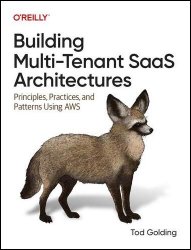 Название: Building Multi-Tenant SaaS Architectures: Principles, Practices, and Patterns Using AWS
Название: Building Multi-Tenant SaaS Architectures: Principles, Practices, and Patterns Using AWSАвтор: Tod Golding
Издательство: O’Reilly Media, Inc.
Год: 2024
Страниц: 487
Язык: английский
Формат: pdf (true)
Размер: 14.4 MB
Software as a service (SaaS) is on the path to becoming the de facto model for building, delivering, and operating software solutions. Adopting a multi-tenant SaaS model requires builders to take on a broad range of new architecture, implementation, and operational challenges. How data is partitioned, how resources are isolated, how tenants are authenticated, how microservices are built—these are just a few of the many areas that need to be on your radar when you're designing and creating SaaS offerings.
In this book, Tod Golding, a global SaaS technical lead at AWS, provides an end-to-end view of the SaaS architectural landscape, outlining the practical techniques, strategies, and patterns that every architect must navigate as part of building a SaaS environment.
• Describe, classify, and characterize core SaaS patterns and strategies
• Identify the key building blocks, trade-offs, and considerations that will shape the design and implementation of your multi-tenant solution
• Examine essential multi-tenant architecture strategies, including tenant isolation, noisy neighbor, data partitioning, onboarding, identity, and multi-tenant DevOps
• Explore how multi-tenancy influences the design and implementation of microservices
• Learn how multi-tenancy shapes the operational footprint of your SaaS environment
Who’s This Book For?
This book is targeted at builder, architect, and operations teams who are creating, migrating, or optimizing SaaS solutions. You might be brand new to SaaS and looking for the foundational concepts that can get you started with SaaS, or you might already be immersed in SaaS and are looking at how you might want to apply the principles outlined here to enhance an existing solution. You’ll notice that I’ve also included operations in this list. While significant parts of this book will be more focused on the builders and architects, there is a clear need for operations teams to be equally immersed in shaping the trade-offs and strategies that will be used to define the footprint of your as-a-service experience. There’s also a corresponding need for builders and architects to be more immersed in the operations experience.
I intentionally start by establishing a clear set of foundational concepts that span the entire book. Even if you have experience with SaaS, I would strongly encourage you to invest in starting with these foundational concepts. The ideas that are established in the early stages of the book challenge some of the classic notions of what it means to be SaaS, introducing terminology and mindsets that influence every aspect of how you design and build a SaaS environment. The examples that show up later in this book illustrate how these design choices and patterns are realized and applied. Having this foundation in place and having good alignment around these core principles will directly influence how you approach the decomposition of microservices, the deployment model of your solution, the identity model you adopt, and so on. My point is that, as you move more into the details of implementation, you’ll see a strong connection between the core principles and the underlying implementation strategies that you might adopt. Being grounded in a common set of guiding principles will allow you and your teams to apply a common set of values throughout the design, development, and operation of your SaaS environment.
There is also a level at which this SaaS content will have value for SaaS leaders and stakeholders. While they may be less interested in the technical details, they are likely to lean on the foundational elements of the book to refine and crystalize their SaaS vision. There are cultural, metric, and team dynamic considerations that come with adopting SaaS, and the success of your organization’s SaaS strategy will rely heavily on having leaders that are rooted in a common set of values. This is often one of the most overlooked aspects of building a best-of-breed SaaS business. For the same reasons, you can imagine how product owners and others connected to the SaaS vision will extract value out of having a firm grasp of these fundamental SaaS principles.
Скачать Building Multi-Tenant SaaS Architectures: Principles, Practices, and Patterns Using AWS